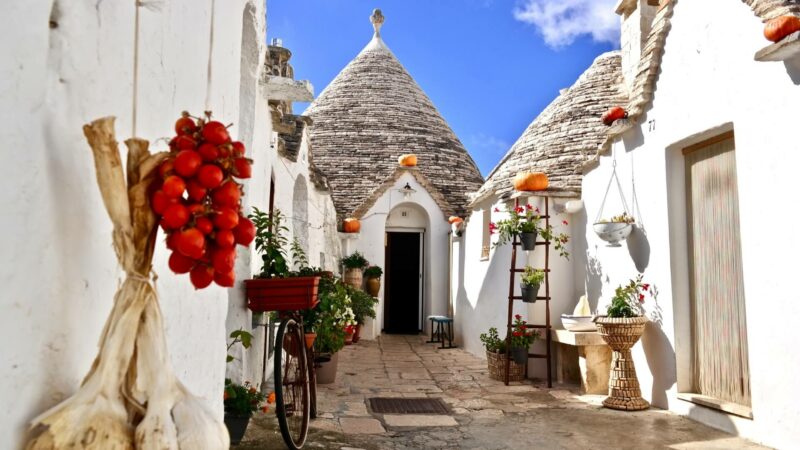Tuscany, at the origins of Italian Identity
It is thanks to the power of the Maritime Republic of Pisa that in the Middle Ages, Tuscany became enriched with castles, towers, and spectacular fortified villages defending the territory. Examples are Monteriggioni, Volterra, and San Gimignano, which is a UNESCO heritage site surrounded by 13th-century walls. Then came Florence, with the influential Medici family as prestigious patrons, grasping cultural hegemony and weaving the golden thread of the Renaissance. Lorenzo the Magnificent transformed the city into a crucible of genius and beauty that shone for three centuries, eventually becoming the capital of the Kingdom of Italy in 1870. Yet, Tuscany is not merely a tale of history and power, but a tapestry of wonders woven by nature itself. The hills of the Orcia valley, at the foot of Mount Amiata, resemble one of the most photographed paintings in the world, with stone gems adorning the landscape and narrating tales of heroes, popes, and poets. Pienza, Castiglione, San Quirico d’Orcia, and Montalcino are small towns where besides sampling the Brunello (an oenological masterpiece revered globally), one can admire the abbeys of San Galgano and Sant’Antimo, jewels of Romanesque architecture.
Additionally, there is the grandeur of Maremma (“a mix of ancient civilization and wildlife”), and the quarries of Carrara, producing the world’s finest marble. We must not forget the stunning and enchanted valleys of Garfagnana and the exclusive coasts of Versilia, a haven for artists and intellectuals. Nestled in the heart of the region, amidst the provinces of Florence, Siena, and Arezzo, lies Chianti, a green sea dotted with villages and vineyards, an orchestra of colors and flavors (primarily of wine but also truffles, Pecorino cheese, olive oil, and charcuterie) which resounds in the memories of each traveler. Then there is the Cypress Avenue of Bolgheri, a road that winds like the verses of a poem among 2540 ancient cypress trees, an icon of the “Made in Italy” beauty. It is also thanks to its wine: the Sassicaia is among the most awarded wine in the world. But Tuscany reveals its treasures on the coast as well: there is the promontory of Argentario – where the sea beds are crystalline, and the paths are hidden by the Mediterranean scrub. The Tuscan Archipelago has its seven islands set in the sea (Elba, Pianosa, Giglio, Capraia, Montecristo, Giannutri, Gorgona), said to have emerged when seven pearls fell from Venus’s necklace…
The cities of Tuscany: an ode to Italian beauty
A reflection of such a prosperous region, the Tuscan cities are an ode to Italian Style. Florence, the capital of the region, is a city steeped in culture and charm. The streets, museums, small and renowned artisan shops, churches, squares, and palaces exude history. They serve as a backdrop to one of the most iconic historic centers in the world, a reference point for art and fashion. Florence offers spectacular architectural masterpieces, such as the Cathedral of Santa Maria del Fiore, the city’s Duomo, with the imposing dome designed by Brunelleschi, and Giotto’s bell tower. These are symbols of Renaissance genius. In addition, there is the iconic Ponte Vecchio, which since the 1600s has hosted goldsmith shops and workshops. Palazzo Pitti, the Boboli Gardens, and the Uffizi Gallery, with their priceless artworks, will stir wonder at the works of Botticelli, Michelangelo, and Leonardo da Vinci. The stunning journey continues with the invaluable beauty of Michelangelo’s David housed at the Accademia Gallery. Along the winding roads that cross hills and vineyards, you reach Siena. Here, it will be easy to get lost in the stone alleys and reach the magnificent Piazza del Campo, the stage for the famous Palio. It is a medieval horse race competition among the 17 districts of the city, held twice a year: on July 2nd and August 16th. Continuing the journey into the jewels of Tuscany, welcome to Pisa. In this city a stone’s throw from the Tyrrhenian Sea, you will find the Piazza dei Miracoli where the famous Leaning Tower stands, along with the Camposanto, the Baptistery, and the Cathedral. Half an hour by car and you enter another gem of art and history, Lucca, which, protected by its sixteenth century walls, preserves a true artistic and architectural heritage (including the birthplace of Puccini).
Tuscany: enjoying bucolic and generous cuisine
After wandering through the picturesque landscapes of Tuscany, with its green hills, wheat fields, vineyards, and olive groves, one can’t help but be swept up by a hearty appetite. Sitting at the table of a wine bar, winery, or inn, it’s time to delve into the delights of traditional Tuscan cuisine. For a satisfying snack, be sure to indulge in the Prosciutto Crudo DOP, the exquisite Lardo di Colonnata IGP, the aromatic Finocchiona IGP (a salami flavored with fennel), and the classic Pecorino Toscano DOP, a cheese steeped in ancient dairy traditions. If you are looking to put together a more succulent and satisfying Tuscan menu, the choice of a Fiorentina steak, another gastronomic icon of the region, can certainly be a great addition. This dish, made with meat from the Chianina breed, is renowned for its tender succulence and robust flavor. You may consider accompanying it with another Tuscan classic such as pappa al pomodoro, a simple yet delicious soup born from peasant wisdom in reusing basic ingredients like stale bread and ripe tomatoes. Another hearty dish is the ribollita, a tasty winter soup made with bread, kale, beans, and winter vegetables. To conclude on a sweet and traditional note, a glass of Vin Santo is a must, perfect for enhancing the flavors and completing the culinary experience. Following that, you could serve cantucci, for almond biscuit lovers, and Ricciarelli di Siena IGP, a soft delicacy made of almond paste, to satisfy even the most refined palates.









